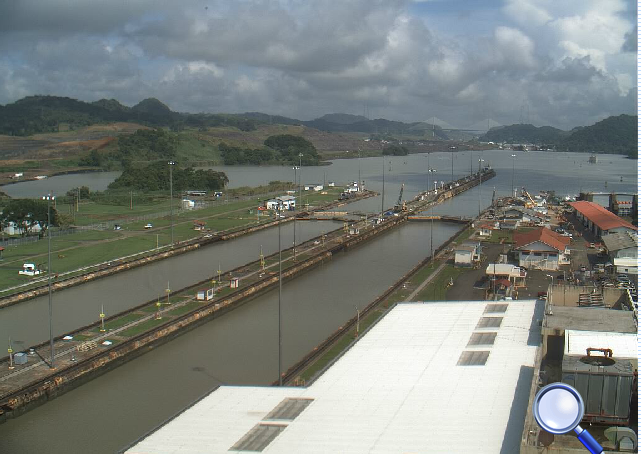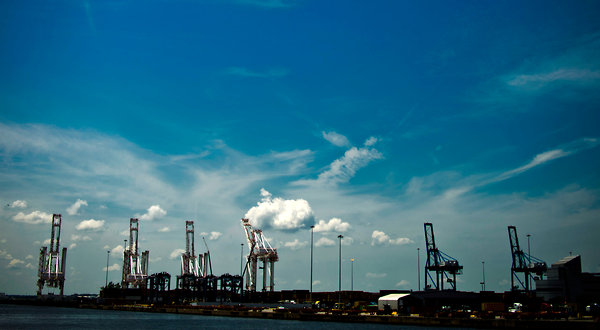Another great article in the Times focused attention on the importance of the Panama Canal Expansion and the impact that it is having worldwide. Click on the picture above to go to the Panama Canal Live webcams
By JOHN SCHWARTZ
Published: August 20, 2012
BALTIMORE — The four cranes rise grandly over the port here, 14 stories high. Just off the boat from China and now being prepared for operations, the $40 million machines are part of this city’s gamble that when supersize container ships start coming through the expanded Panama Canal in 2015, Baltimore will be one of the few ports on the East Coast ready for their business.
“We think it’s going to be a major win for us,” said James J. White, the executive director of the Maryland Port Administration.
This sense that the new set of locks now being built to allow giant ships through the canal will bring riches 1,000 miles or more to the north is shared by industry and government officials along the East Coast and the Gulf of Mexico, who have been promoting multimillion- — and in some cases multibillion- — dollar port projects for years. The Obama administration has now moved to speed up the review process for developing and deepening the harbors for several of these ports, including those of New York and New Jersey; Charleston, S.C.; Savannah, Ga.; Jacksonville, Fla.; and Miami. The initiative “will help drive job growth and strengthen the economy,” President Obama said in announcing it last month.
But some who are following the efforts have begun to express skepticism about the hope and money going into dredging mud and raising steel. With so many ports competing for a share of the bounty, experts are questioning how big that bounty will be. “Everybody is trying to go after it — there are going to be few beneficiaries, in my judgment,” said William D. Ankner, a former official of the Port Authority of New York and New Jersey and a former secretary of transportation for Louisiana.
The big ships — known as “Post-Panamax” and even “Super-Post-Panamax” — are already in heavy use worldwide, making up 16 percent of the container fleet but accounting for 45 percent of its capacity, according to a July report by the Army Corps of Engineers. And “those numbers are projected to grow significantly over the next 20 years,” said Maj. Gen. Michael J. Walsh, deputy commanding general for civil and emergency operations for the corps, in announcing the report.
In the race that began when plans for the expansion were first announced in 2006, some winners have already emerged. The Port of Virginia, in Norfolk, is ready to receive the big ships today. And New York is also prepared, thanks to a massive dredging project that began 13 years ago.
But nearly every port in the game still faces major challenges and expenses — including the Port Authority of New York and New Jersey, which plans to spend $1 billion to raise the Bayonne Bridge roadway by 64 feet to allow the giant ships through on their way to to Newark and Elizabeth, N.J.
Baltimore, which already has a 50-foot channel, has a bottleneck on the land side: the Howard Street tunnel, through which trains have to pass to reach the port, and which is too small to accommodate the double-stacked container cars that are increasingly the standard for rail shipping. The rail line CSX has announced a workaround that could cost hundreds of millions, involving a new yard beyond the tunnel filled with containers brought by truck; the port will load the trains with a single container to get through the tunnel, and the trains can be completed at the yard.
Miami is putting $2 billion into improvements to its port; its dredging project was approved by the Army Corps of Engineers in April, and the city is building a tunnel costing an estimated $1 billion to create a crucial link between the port and the Interstate System of highways.
Savannah is preparing to move forward with a $652 million deepening project, while the South Carolina Legislature has committed $300 million to dredging for Charleston. A plan for the two cities to team up on a common port has all but stalled.
The big ships will also come via places beyond Panama: many are expected to come from Southeast Asia through the Suez Canal, and from South America’s eastern ports.
But more fundamental questions have been raised about the real benefits of the coming trade, and especially the effects of the new canal traffic.
Moving goods by water is generally cheaper than moving them by land because of the economies of scale of moving so many containers on those big ships, said John Martin, a ports consultant in Lancaster, Pa. So that would suggest canal routes will offer lower-cost shipping to the East Coast and Midwest through the canal.
But, he said, containers loaded on the West Coast, which has built up its container yards and highway and rail infrastructure, can outrun those that travel to the East Coast by water, and that can make the difference when speed and dependability are more important than cost alone. Besides, he added, costs and fees can shift; Panama can be expected to raise rates for canal passage, and “the railroads are not going to sit idly by” and let the water route undercut their business.

